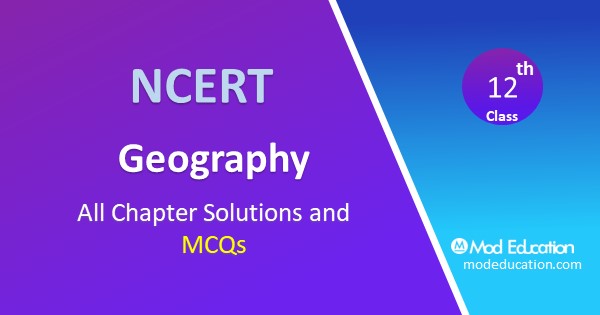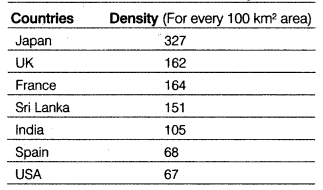Class 12 Geography Notes Chapter 8 : NCERT CBSE RBSE and Other State Board Solutions for Class 12 Geography Notes for Chapter 8 Transport and Communication Notes questions answers MCQs Download PDF

Class 12 Geography Notes Chapter 8 Transport and Communication
ransport
Transport is a facility or a service for the carriage of persons and goods from one place to another using humans, animals and different kinds of vehicles. It is an organised service industry that handles loading, unloading and delivery.
Modes of Transportation
- The main modes of transportation are land, water, air and pipelines. These are used for inter-regional and intra-regional transport, and each one (except pipelines) carries both passengers and goods.
- Several places (nodes) join together by a series of routes (links) to form a pattern is called transport network.
Land Transport
This includes movement of goods and services over land i.e. roads and rails. Earlier humans themselves were carriers such as in palanquin (palki or doli), later pack animals such as mules, horses, camels were used. Dogs and reindeers were used in North America. In India, bullocks were used to pull carts. The revolution came after invention of steam engine in 18th century that started railways and roadways with the invention of internal combustion engines.
Among the new means of land transport are pipelines, ropeways and cableways. Rope and cableways are generally found on steep mountain slopes and mines, which are not suitable for building roads.
Roads
It is most economical for short distance and gaining importance for freight transport due to its door to door service. Metalled roads are all weather roads while unmetalled roads are not serviceable in all seasons due to their simple construction. Though heavy rains and floods make both the roads unserviceable. The quality, construction and maintenance of roads is better in developed countries than in developing countries as it requires heavy expenditure.
Road Density
- The total motorable road length of the world is only about 15 million km, in which North America separately accounted 33%. Although, North America in compare to Western Europe registered highest number of vehicles as well as highest road density.
- Road density is the total length of roads per hundred square kilometre of area.
Countries and their Road Density

Traffic Flows
It refers to traffic on roads that has increased dramatically in recent years. As the road network cannot cope with the demands of traffic, so congestion occurs.
Highways
They are metalled roads connecting distant places for unobstructed vehicular movement. These are 80m wide with separate traffic lanes, bridges, flyovers and dual carriageways
In North America, there is dense network of highways. Pacific coast is linked to Atlantic coast, Vancouver is connected to Newfoundland by Trans-Canadian highway and Edmonton is connected to Anchorage through Alaskan highway.
Trans-continental Stuart highway connects Darwin, Melbourne to Alice springs in Australia. Europe has well developed highway network. Moscow-Vladivostok highway is important for Russia. Highways criss-cross the country in China.
In India, National Highway No.7 (NH7) connecting Varanasi and Kanyakumari is the longest highway of the country. (The golden quadrilateral or super expressway is under construction). Now, NH-44 became the longest running highway in India. It connects Srinagar to Kanyakumari. NH-7 is renamed as National Highway 44. In Africa, Algiers in North is connected to Guinea and Cairo connected to Capetown in South.
Border Roads
These are roads laid along international boundaries. These roads help in transport of goods to border areas and military camps.
Railways
Railways are best suited for the transportation of bulky goods and passengers over long distances. Highly industrialised areas, urbanised regions and mineral rich areas are linked to railways for the transportation of ores, grains, timber and machinery. All the continents have dense network while Europe is having the highest density of railways. The railway network of Africa, Asia and South America connects the mineral rich and fertile areas and is developed primarily to utilise the natural resources.
Trans-Continental Railways
The railway line that runs across the continent and links its two ends is called a trans-continental railway line. They are constructed for economic and political reasons.
The following are the most important of these:
Trans-Siberian Railway
It is in Russia and the longest railway in the world. It runs between St. Petersburg in West to Vladivostok in East, passing through Moscow, Irkutsk, Chita, etc. It links important agro centre with fur centre connecting rail routes to important cities of Asia.
Trans-Canadian Railway
Constructed in 1886, it is 7050 km long railway in Canada that links Halifax in East to Vancouver in West. It passes through the industrial region connecting the wheat belt of Prairies and the coniferous forest area so it is considered economic artery of Canada. Wheat and meat are the important exports on this route.
The Union and Pacific Railway
This rail line connects New York on the Atlantic coast to San Francisco on the Pacific coast passing through Cleveland, Chicago, Omaha, Evans, Ogden and Sacramento. The most valuable exports on this route are ores, grain, paper, chemicals and machinery.
The Australian Trans-Continental Railway
This rail line runs West-East across the southern part of the continent from Perth on the West coast to Sydney on the East coast passing through Kalgoorlie broken hill and port Augusta. Another North-South line connects Adelaide and Alice spring and to be joined later to the Darwin-Birdum link.
The Orient Express
This line runs from Paris to Istanbul passing through Strasbourg, Munich, Vienna, Budapest and Belgrade. It has reduced the 10-day journey to only 4 days. Cheese, wine, bacon, oats, fruits and machinery are chief exports on this rail route.
Water Transport
This is the cheapest mode of transport as no construction cost is there and very little maintenance cost. The linking of oceans have brought greater navigation with ships of various sizes. Water transport is divided into sea routes and inland waterways.
1. Sea Routes
Sea and oceans provide smooth highway traversable in all directions with no maintenance costs. Modem passenger ships and cargo ships are equipped with various navigation aids. The important sea routes are as follows:
North Atlantic Sea Route It links North-Eastern USA and North-Western Europe. It is the busiest in the world and also called Big Trunk route.
Mediterranean-Indian Ocean Sea Route This route connects industrialised Western Europe with West Africa, South Africa, South-East Asia, Australia and New Zealand. Natural resources such as gold, diamond, copper, tin, groundnut, oil palm, coffee and fruits are transported through it.
Cape of Good Hope Sea Route This route links West Europe and West African countries with Brazil, Argentina and Uruguay in South America. Traffic is less on this route because the countries falling in this route have similar products and resources.
The North Pacific Sea Route This route connects the ports on the West coast of North America with those of Asia. These are Vancouver, Seattle, Portland, San Francisco and Los Angeles of American side with Yokohama, Kobe, Shanghai, Hong Kong, Manila and Singapore of Asian side.
The South Pacific Sea Route This route is used for reaching Hong Kong, Philippines and Indonesia and also links Western Europe and North America with Australia, New Zealand and Pacific Islands via the Panama Canal. Panama is 12000 km far from Sydney. Honolulu is an important port on this route.
Coastal Shipping Coastal shipping is a convenient mode of transportation with long coastlines, e.g. USA, China and India. This type of shipping can reduce congestion on land routes.
Shipping Canals
There are two canals that serve as gateways of commerce for both the Eastern and Western worlds. They are:
The Suez Canal Constructed in 1869, it is a man-made canal linking the Mediterranean sea and the Red sea. It is 160 km long and 11 -15 m deep without any locks and sea water flows freely through it.
The Panama Canal It is a man-made canal linking Atlantic ocean with Pacific ocean. It is 72 km long and involves a deep cutting for a length of 12 km and has 6 locks. It shortens the distance between New York and San Francisco by 13000 km by sea.
2. Inland Waterways
Rivers, canals, lakes and coastal areas are inland waterways for the transportation of cargo and passengers. The development of inland waterways depends on navigability, water flow and transport technology. The important inland waterways are: The
Rhine Waterways This waterway links the industrial areas of Switzerland, Germany, France, Belgium and the Netherlands with the North Atlantic sea routes. The river Rhine flows through Germany and Netherlands. It flows through a rich coal field, Dusseldorf is an important port in this region. This waterway is the world’s most heavily used. More than 20,000 ocean-going ships and 200,0 inland vessels move from this waterways every year.
The Danube Waterway The Danube river which is navigable upto Tauma Severin, emerges in the Black Forest. It is used mainly for the export of wheat, maize, timber and machinery.
The Volga Waterway Volga is one of the developed waterways of Russia. It is navigable upto 11,200 km and drains into the Caspian Sea.
It is connected to Moscow region and the Black Sea through Volga-Moscow canal and Volga-Don canal respectively.
The Great Lakes-St Lawrence Seaway The Great Lakes alongwith estury of St Lawrence river form a waterway in North America. Duluth and Buffalo are two important ports on this route.
The Mississippi Waterways The Mississippi-Ohio waterway links the interior part of USA with the Gulf of Mexico in the South. Large steamers can move upto Minneapolis.
Air Transport
It is the fastest means of transport but it is very costly. Air transport has brought connectivity revolution in inhospitable deserts, mountainous regions and snow fields where other means of transport are not reachable. Due to high construction and maintenance cost, air transport is more developed in highly industrialised countries. Supersonic aircrafts cover the distance in very short time.
Inter- Continental Air Routes
USA accounts for 60% of airways of the world. Important cities are nodal points where air routes converge or radiate to all continents. Africa, Asiatic part of Russia and South America lack air services, sparser population or limited landmass or low economic development.
Pipelines
These are used to transport water, petroleum, natural gas, liquidified coal for an uninterrupted flow. Milk is supplied through pipelines in New Zealand. USA has dense network of pipelines. Big Inch is famous pipeline of USA that transports petroleum from the oil wells of the Gulf of Mexico to the North-Eastern states. In Europe, Russia,
West Asia and India, oil wells are linked to refineries through pipelines.
Communications
Long distance communication in the form of telegraph and telephone are important. In mid-19th century, American Telegraph and Telephone company (AT&T) enjoyed monopoly. In developing countries the use of cell phones has gained importance for rural connectivity.
Latest technology developments have resulted in Optical Fibre Cables (OFC). They allow large quantities of data to be transmitted that are virtually error free. Now the telecommunication merged with computers to form integrated networks termed as Internet.
Satellite Communication in India
Artificial satellites are deployed in Earth’s orbit to enhance communication and improve connectivity. This is satellite communication which has reduced the per unit cost and time of communication also.
India developed its own satellite Aryabhatta and launched it on 19th April, 1979, Bhaskar -I in 1979 and Rohini in 1980. Bhaskar, Challenger and INSAT-IB satellites are used for long distance communication and weather forecasting.
Cyber Space-Internet
This is the latest technology in which there is instant connectivity by accessing the electronic computerised space. It is called cyber space or Internet and is encompassed by the World Wide Web (www).
Majority of Internet users are in USA, UK, Germany, Japan, China and India. The social and economic space has expanded through e-mail, e-commerce, e-leaming and e-governance.
